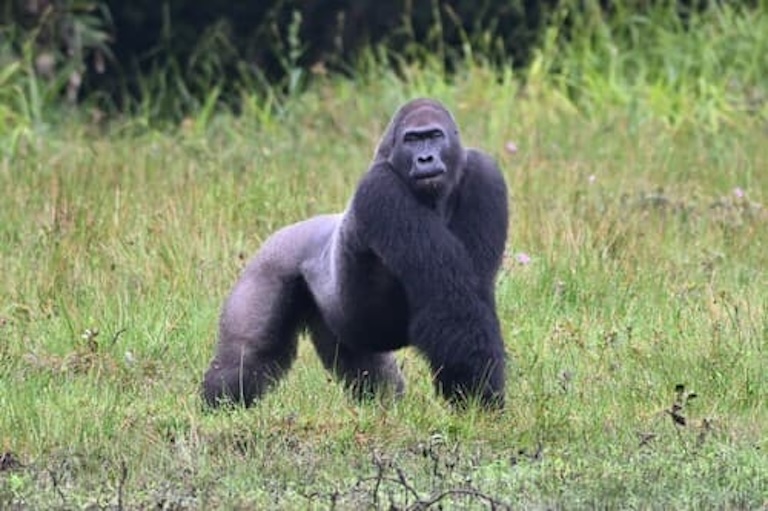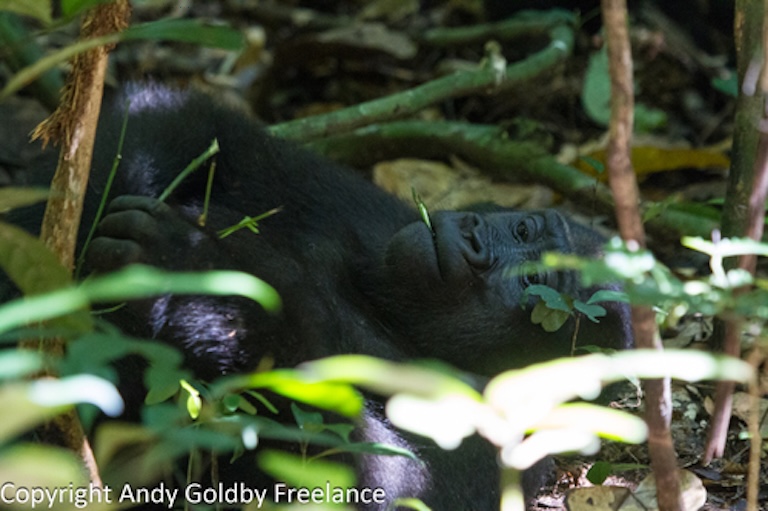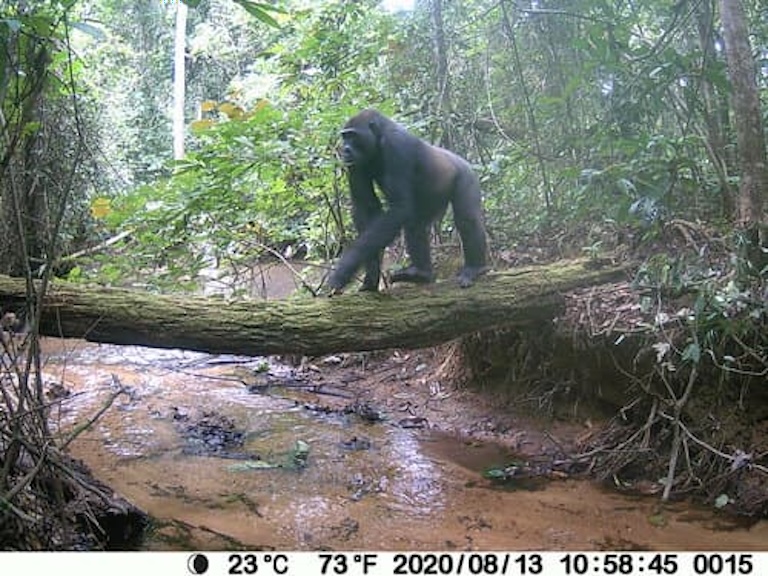Western Gorilla Profile
In 1967, a hypothetical scenario was artistically described in which the American bison was bullying some other members of its species from a New York population. This bullied party, in turn, passed on their oppression to others within their group.
This entirely fictional event was summed up in the sentence, “Buffalo buffalo Buffalo buffalo buffalo buffalo Buffalo buffalo”.
The ridiculous sentence pushed the very real and much more important subject of today’s post to the second spot on the list of fun things to say out loud. Gorilla gorilla gorilla, along with Gorilla gorilla diehli, make up the Western gorillas; a pair of highly endangered subspecies of great ape.

Western Gorilla Facts Overview
| Habitat: | Montane forest, swamp forest and forested hills |
| Location: | Western Central Africa |
| Lifespan: | 40 years in the wild |
| Size: | Up to 176 cm (5’ 9.3”) in large males |
| Weight: | 170kg (375lb) |
| Colour: | Black or dark grey |
| Diet: | Mostly fruit, also leaves, shoots and insects |
| Predators: | Humans |
| Top Speed: | Unverified |
| No. of Species: | 1 |
| Conservation Status: | Criticially Endangered (IUCN) |
The Western Gorilla species almost paradoxically comprises both the most abundant and rarest subspecies of gorilla, but for a genus that is either endangered or critically endangered across the board, even their high numbers are quite a low bar.
These are intelligent, gentle cousins of humans, and still, they are decreasing faster than we can learn some of the fundamentals about how they spend their lives.
Interesting Western Gorilla Facts
1. They’re smart!
Gorillas had been observed in zoos for a long time, making use of sticks to ‘fish’ for ants, and as a way of reaching toys, but it was as late as 2005 before researchers witnessed this behaviour in the wild.
The first documented case of gorilla tool use in the wild involved a female fetching a long stick to use as a measure of depth in the water, to make sure it was safe enough to forage.
This is not a behaviour that’s unique to apes, but it is a sign of significant intelligence, and a suggestion that we could have had some technological competition if these animals weren’t so laid back.
Gorillas of other species have also been witnessed grieving their dead, which shows high emotional and social complexity too. 1 2

2. They’re pretty chilled
Despite being the most powerful and massive species of ape, these are gentle giants, far less likely to engage in aggressive behaviour than almost any of their hominid relatives (especially humans).
Their groups are normally led by a huge, dominant male, but fights aren’t that common, and order is maintained more through symbolic displays and stern looks than physical interactions.
These are thoughtful, intelligent animals, and while killing one another is commonplace in human and chimp societies, it’s rarely been documented in gorillas at all. 3
3. They’re in trouble
Most recent estimates are still heavily outdated, but some set the total number to around 362,000 and declining. Other estimates bring that total closer to 200,000.
Western gorillas are hard to study on account of their range overlapping with some of the least politically stable nations on Earth.
It’s a dangerous world for researchers and gorillas alike, and continued pressure from logging, diseases, and hunting for food by the increasing human presence has led to their numbers dropping.
Despite Western Lowland Gorillas being at least a hundred times more populous than other species, this isn’t as positive as it sounds. With populations decreasing at an accelerating rate, the prognosis doesn’t look good, and the species is considered critically endangered.
Other, less populous species are increasing in number, and while there aren’t so many of them, this has led to their status improving to simply ‘endangered’. 4 5
4. The Cross-River Gorillas are even rarer
190 miles North of the Northernmost populations of Western Lowland gorillas are the Cross River gorillas.
This subspecies, Gorilla gorilla diehli, is a genetically distinct group, isolated for long enough to diverge to the point of earning themselves a slightly different taxonomic name, though still close enough genetically to the lowland subspecies to breed with them if given the chance.
Sadly, this chance is unlikely to present itself naturally, and this isolated subspecies is now the rarest of all the great apes. In fact, they aren’t even able to find members of the same subspecies to mate with.
There are around 11 groupings of these gorillas, and possibly as few as 250 individuals remain, many of whom would have had connections with one another in the past via habitat corridors that have since been destroyed.
This makes their subpopulations more isolated, and threatens their genetic diversity, leading to increased risk of extinction simply because members of the species can’t find one another to breed healthy offspring.
These small populations have been pushed to higher elevations and rockier terrain, sometimes away from preferred food sources, as a result of poaching pressure for bushmeat and other human activity.

5. Isolation of these populations leads to genetic problems
As human activity cuts into the forest, it partitions gorilla habitats, creating settlements, roads, or farmland that animals can’t cross.
Essentially what this isolation does is force populations to breed with members of their species who are dangerously closely related to them. This is inbreeding, and it’s a necessary product of habitat fragmentation.
So, while the overall number of individuals within a species can be high if they are split into fragments and can’t mate with one another, their recessive, deleterious genes can be activated.
This can cause obvious deformities or less visible malfunctions in things like hormones or a decrease in diversity in immune system genes.
As a result, they become much more vulnerable to other threats.
6. Geneticists think that subpopulations were only separated very recently
At least one study shows that divergence in gene flow between populations is a very recent phenomenon, and at least up until recently, there was dispersal between these groups of Cross-river gorillas.
This reinforces the argument that conservation plans should focus on providing corridors between groups and maintaining those that still exist, as a way of protecting the genetic health of the subspecies. 6
7. They reproduce slowly
The sexual maturity of a male Western gorilla can take as long as 18 years. This is shorter in females, but gestation is no quick process, either, at 256 days – just about two weeks shorter than that of humans.
Reproductive cycles are hard to assess, and much is still unknown about their length in this species, but it’s thought that if all negative impacts were removed, it would take at least 75 years for the Western Lowland Gorilla to repopulate to healthy levels.
8. Protection efforts can still work
As well as the more conventional conservation efforts such as reforesting and protecting lands, other tried and tested methods of gorilla conservation have shown promise in Eastern species.
Assigning and then heavily guarding protected areas is the best way to keep this species safe, particularly for the Cross-river subspecies. This, of course, is easier said than done, and ecotourism needs to play a role in this.
However, the dangers of the locations in which these gorillas live make tourism money harder to come by.
Until regions can be considered relatively safe to travel in, this species of gorilla is unlikely to gather much attention, and so conservation programs need government and local support to create a stable environment and exploit this opportunity to bring money both into the countries involved and into gorilla conservation.
Western Gorilla Fact-File Summary
Scientific Classification
| Kingdom: | Animalia |
| Phylum: | Chordata |
| Class: | Mammalia |
| Order: | Primates |
| Family: | Hominidae |
| Genus: | Gorilla |
| Species: | Gorilla |
| Subspecies: | Gorilla |
Fact Sources & References
- GRETCHEN VOGEL (2005), “Wild Gorillas Pick Up Tools”, Science.
- Author Name (Year), “Article Name”, Publication.
- Stacy Rosenbaum (2016), “Observations of severe and lethal coalitionary attacks in wild mountain gorillas”, scientific reports.
- “WESTERN LOWLAND GORILLA”, World Wild Life.
- “Western Gorilla”, IUCN Red List.
- RICHARD A. BERGL (2007), “Genetic analysis reveals population structure and recent migration within the highly fragmented range of the Cross River gorilla (Gorilla gorilla diehli)”, Wiley Online Library.
